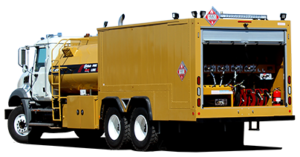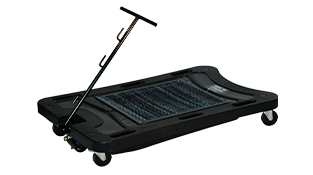On the jobsite, a piece of machinery is only making you money when it’s running. Downtime — whether from unexpected breakdowns or routine maintenance — is a quick culprit of productivity and revenue loss. At the end of the day, anything you can do to keep the wheels turning and engines running will contribute to an operation’s bottom line.
Sage mobile lube systems can make a universal task quicker and more efficient, helping every machine spend more time doing its job. Like any piece of equipment on a worksite, a Sage system is designed to take care of a very specific function: Conduct lubrication and oil changes in the field. That makes it important to purchase and operate the right system to meet your specific mobile lubrication and maintenance needs with minimal work disruption, helping sustain and improve the return on investment (ROI) of machinery and equipment.
“Whether you’re moving beyond using buckets to manually change oil, driving machinery back to a shop to conduct maintenance or you’re upgrading from a different type of mobile lubrication system, a Sage system can help you keep your machinery operating by efficiently taking care of these common maintenance tasks in the field,” said Sage CEO Aaron Sage. “To maximize that efficiency, you have to match your Sage system to your specific jobsite maintenance needs.”
Here are a few things to consider in determining which Sage system is right for your operation.
Your biggest fluid management pain points: This may be the mess of manual oil changes, the time required to conduct maintenance with current methods or having the right workforce to do the job efficiently.
What you’re using to change oil now: Are you changing oil manually with buckets, or using another type of lubrication maintenance system?
Where you’re conducting maintenance: Are you changing oil and servicing machinery in a central shop or doing it on the job site?
How much machinery you’re maintaining: How many machines and different types are you maintaining?
Service frequency: How often do you change oil in the machines you service?
Maintenance services you’re providing: Are you simply topping off fluids on-site and seldom conduct full oil changes, transmission and full hydraulic exchanges, as well as 250 hour engine oil changes?
Current equipment: Do you already have trucks, skids or trailers? What is your existing payload or towing capacity?
Time on the road: How far do you travel between jobsites? How far do you travel before you make it back to the shop?
How you handle waste fluids: Do you dispose of used engine oil and other fluids in a central location? How frequently do you dispose of waste fluids?
Working conditions: Do you change oil and provide maintenance in cold temperatures that would require heated fluid tanks? Do you work best in an open or enclosed system?
Working with used oil filters: Consider ways to avoid the messiest part of the job with a Filter Stinger and used filter receptacle
Other tools and equipment: Do you have your own compressor? Do you need storage for supplemental jobsite tools and equipment?
Answering these questions about your specific operation is especially important, given the range of Sage mobile lube equipment options ranging from lube carts and skids to the largest trailers and Class 8 trucks that can provide service to multiple pieces of machinery on different jobsites. Once you know the specific improvements you want to make to your jobsite maintenance operations, it can help you know what system will work best for your business, in both the short and long term.
“Being able to identify these parts of your operation is important to your ability to select the right Sage system that can both meet your needs as well as fit in with existing equipment and processes,” Sage said. “Starting the process of integrating a Sage system — whether a lube truck, skid or trailer — into your business by having a clear picture of where you stand today can help you identify the direction to go in the future to achieve gains in productivity and efficiency that can help your business grow. We think of Sage systems as not just tools to do a job, but components of a strong growth strategy.”
Start the process to evolving your mobile lubrication services by checking out the range of Sage system options.













